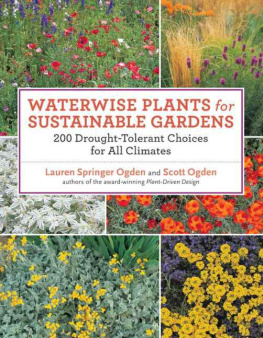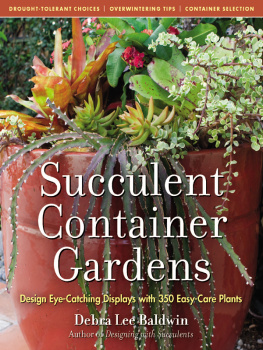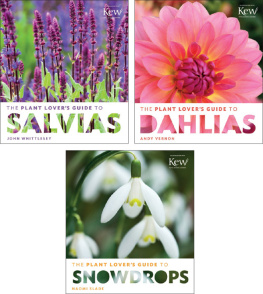Waterwise Plants for Sustainable Gardens

Waterwise Plants for Sustainable Gardens
200 Drought-Tolerant Choices for All Climates
Lauren Springer Ogden and Scott Ogden

Copyright 2011 by Lauren Springer Ogden and Scott
Ogden. All photographs by the authors.
All rights reserved.
Published in 2011 by Timber Press, Inc.
The Haseltine Building
133 S.W. Second Avenue, Suite 450
Portland, Oregon 97204-3527
www.timberpress.com
2 The Quadrant
135 Salusbury Road
London NW6 6RJ
www.timberpress.co.uk
Printed in China
Library of Congress Cataloging-in-Publication Data
Ogden, Lauren Springer.
Waterwise plants for sustainable gardens : 200 drought
tolerant choices for all climates / Lauren Springer Ogden
and Scott Ogden. 1st ed.
p. cm.
Includes bibliographical references and index.
ISBN 978-1-60469-169-6
1. Drought-tolerant plantsUnited States. 2. Xeriscap
ingUnited States. I. Ogden, Scott. II. Title.
SB439.8.O34 2011
635.9525dc22
2011012386
A catalog record for this book is also available from the
British Library.
Contents











Introduction Rewarding Gardens Under Rainless Skies

IN THIS BOOK we have brought together two hundred beautiful plants especially selected for gardens that experience drought at some point during the year. Climate is changing and weather is becoming more erratic and unpredictable all over, even in traditionally moist regions. More and more people now grow plants in dry parts of the West, while expanding populations strain water supplies around the globe. Sustainability is the word of the day and for the future; plants that need little water and tolerate drought offer solutions for gardeners and homeowners everywhere. Plants featured here include stunning performers that are reliable under ordinary landscape conditions as well as drought. Weve included many adapted widely enough to enrich gardens not only in arid western North America but also in the Northeast, Midwest, Southeast, Pacific Northwest, and United Kingdom.
Choosing the best plants is the starting point for creating a sustainable, rewarding garden, what we advocate as plant-driven design, and what we hope to help you with in this book. Intelligent gardens and landscapes are democratic. If a plant is beautiful, well adapted to the site and region, and not overly aggressive or invasive, it deserves consideration. If it needs little input in terms of soil amendment, fertilizer, or ongoing care, better yet. If it supports a range of creatures with food, cover, or nesting places, its a win-win for all. We have used these criteria to pick the two hundred plants described here. With drought-resistant plants, less is truly more.
Gardening with Limited Water
When fully established, plants in this book all remain attractive with just 1 inch of water (rain or irrigation) every two weeks during the hottest part of peak growing season. They need much less during cooler times and when plants are not in full, active growth. For practical purposes this is how we define low-water, waterwise, or drought-tolerant plants. New plantings require more regular water: 1 inch (rain or irrigation) every week through the first growing season, trees sometimes for a second season.
In nature many plants rely on residual fall, winter, or spring moisture from snowmelt or seasonal rains; they grow strongly early in the season, then enter a resting phase during hotter, drier weather unless awakened by thundershowers or monsoonal rains. Infrequent deep irrigation encourages plants to root deeply and makes them more durable in drought. Frequent shallow irrigation can have the opposite effect and may bring alkaline salts to the surface, tying up nutrients and burning plant roots. Placing cisterns to collect rainwater, or creating curb cuts, swales, and rain gardens to redirect and conserve runoff, and building up and increasing the depth of soil over shallow rocky terrain all maximize capture, preservation, and availability of precious water.
Inorganic mulches such as pea gravel or grit in neutral colors make natural, long-lasting surfaces for waterwise gardens that help reduce soil temperatures while limiting moisture loss and the need to irrigate. Organic mulch materials such as shredded bark, wood chips, and compost are not natural to dryland environments and are best avoided near most drought-tolerant plants, as they may tie up nutrients and inhibit growth while decaying and can promote disease as well as release substances harmful to plants. Trees have deeper roots and thick protective bark and naturally grow amid fallen leaves and woody debris, so they are an exception to this.
All the plants in this book prefer well-drained soils; none require added fertilizer in garden situations.
What You'll Find Here
For each of our two hundred plant selections weve included symbols and text indicating common and botanical names, preference for sun or shade, mature size, general bloom periods (though these vary with climate and region), and where the plant is best adapted. Zones refer to the USDA zone chart on page 11; we include important additional regional information such as tolerance to heat and humidity, and performance on the West Coast (which applies to similar Mediterranean climates as well). We also let you know if a plant is native to North America, and if its beneficial to wildlife, while not leaving out if its resistant to browsing deera common concern from coast to coast.
Next page



















